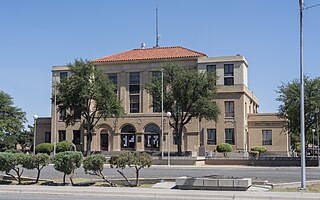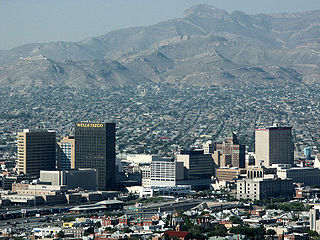
Reeves County is a county located in the U.S. state of Texas. As of the 2020 census, its population was 14,748. Its county seat and most populous city is Pecos. The county was created in 1883 and organized the next year. It is named for George R. Reeves, a Texas state legislator and colonel in the Confederate Army. It is one of the nine counties that comprise the Trans-Pecos region of West Texas. Reeves County comprises the Pecos micropolitan statistical area.

Kinney County is a county located in the U.S. state of Texas. As of the 2020 census, its population was 3,129. Its county seat is Brackettville. The county was created in 1850 and later organized in 1874. It is named for Henry Lawrence Kinney, an early settler.

Jeff Davis County is a county in the U.S. state of Texas. As of the 2020 census, its population was 1,996. Its county seat is Fort Davis. The county is named for Jefferson Davis, who served as the 23rd United States Secretary of War in the 1850s, and as Confederate president.

Guadalupe County is a county located in the U.S. state of Texas. As of the 2020 census, its population was 172,706. The county seat is Seguin. The county was founded in 1846 and is named after Guadalupe River.

El Paso County is the westernmost county in the U.S. state of Texas. As of the 2020 census, the population was 865,657, making it the ninth-most populous county in the state of Texas. Its seat is the city of El Paso, the sixth-most populous city in Texas and the 22nd-most populous city in the United States. The county was created in 1850 and later organized in 1871.

Culberson County is a county located in the U.S. state of Texas. As of the 2020 census, its population was 2,188. The county seat is Van Horn. Culberson County was founded in 1911 and organized the next year. It is named for David B. Culberson, a Confederate soldier and U.S. representative.

Comal County is a county located on the Edwards Plateau in the U.S. state of Texas. As of the 2020 census, its population was 161,501. Comal County is known for its rich German-Texan and European history. Its county seat is New Braunfels.

Van Horn is a town in and the seat of Culberson County, Texas, United States. According to the 2010 census, Van Horn had a population of 2,063, down from 2,435 at the 2000 census. The 2020 census results detailed a decline in population to 1,941. Van Horn's official newspaper is The Van Horn Advocate. The town is the westernmost incorporated community in the United States that uses the Central Time Zone, located on the same line of longitude as Cheyenne, Wyoming, and Colorado Springs, Colorado. Its earliest sunset in the beginning of December is the latest among incorporated towns in the United States, occurring no earlier than 5:56 pm.

Tornillo is a border town in El Paso County, Texas, United States. The population was 1,568 at the 2010 census. For statistical purposes, the United States Census Bureau has defined this unincorporated community as a census-designated place (CDP). It is part of the El Paso Metropolitan Statistical Area. The Tornillo and Guadalupe, Chihuahua, area is connected by the Tornillo–Guadalupe International Bridge.

Dell City is a city in Hudspeth County, Texas, United States. The population was 365 at the time of the 2010 census, down from 413 at the time of the 2000 census. The population is now at 245 by the 2023 census. It is near the former location of Paulville, a failed Ron Paul-inspired Libertarian cooperative and planned community.

Fort Hancock is an unincorporated community and census-designated place (CDP) in Hudspeth County, Texas, United States. Its population was 1,052 at the 2020 census.

Sierra Blanca is an unincorporated area in Hudspeth County, Texas, United States. It is also the county seat of the county and the namesake of a census-designated place (CDP) in which it is located. The town is part of the Trans-Pecos region of far West Texas, is located northeast of the Mexican border and is within the Mountain Time Zone. As of the 2020 census, its population was 315.

Mescalero or Mescalero Apache is an Apache tribe of Southern Athabaskan–speaking Native Americans. The tribe is federally recognized as the Mescalero Apache Tribe of the Mescalero Apache Reservation, located in south-central New Mexico.

The Trans-Pecos, as originally defined in 1887 by the Texas geologist Robert T. Hill, is the distinct portion of Texas that lies west of the Pecos River. The term is considered synonymous with Far West Texas, a subdivision of West Texas. The Trans-Pecos is part of the Chihuahuan Desert, the largest desert in North America. It is the most mountainous and arid portion of the state, and most of its vast area is sparsely populated. Among the nine counties in the region are the five largest counties by area in Texas and eight of the eleven largest in the state. The area is known for the natural environment of the Big Bend and the gorge of the Rio Grande, part of which has been designated a National Wild and Scenic Rivers System. With the notable exceptions of Big Bend Ranch State Park, Big Bend National Park and the Guadalupe Mountains National Park, the vast majority of the Trans-Pecos region consists of privately owned ranchland. However, most of the region's population reside in the El Paso metropolitan area. Besides El Paso and its metropolitan area, the major cities are Pecos (12,916), Fort Stockton (8,466), and Alpine (6,035). All other settlements have under 5,000 people.

Dell City Independent School District (DCISD) is a public school district based in Dell City, Texas (USA). The district operates Dell City School, which covers grades Kindergarten through 12 and serves students in northern Hudspeth County. Dell City School is classified as a 1A school by the UIL. In 2016, the school was rated "Improvement Required" by the Texas Education Agency. In addition to northern Hudspeth County, it also serves areas of southeast Otero County, New Mexico as part of an inter-district agreement with Alamogordo Public Schools due to the area's lack of proximity to the Alamogordo district's schools.
Allamoore is a small, unincorporated community in Hudspeth County, Texas, United States. It is located just north of Interstate 10, approximately 22 miles (35 km) southeast of Sierra Blanca and 11 miles (18 km) west of Van Horn.
Fort Quitman was a United States Army installation on the Rio Grande in Texas, United States, south of present-day Sierra Blanca, 20 miles southeast of McNary in southern Hudspeth County. The fort, now a ghost town, was named for former Mississippi Governor John A. Quitman, who served as a major general under Zachary Taylor during the Mexican–American War.

Acala is an unincorporated community and census designated place (CDP) in Hudspeth County, Texas, United States, located 34 miles (55 km) northwest of Sierra Blanca and 54 miles (87 km) southeast of El Paso, with a population in 2020 of 11. Acala is located on Highway 20. Acala was named for acala cotton, a type of cotton produced in Mexico.

The El Paso–Las Cruces, Texas–New Mexico, combined statistical area consists of two counties in western Texas and one in southern New Mexico. This CSA was defined as part of the United States Office of Management and Budget's 2013 delineations for metropolitan, micropolitan, and combined statistical areas.< As of the 2023 United States Census Estimate, the El Paso-Las Cruces CSA had a population of 1,098,541 making it the 56th largest combined statistical area in the United States. The statistical area consists of the metropolitan areas of El Paso, Texas and Las Cruces, New Mexico. This CSA has a GDP of about $33 billion and would rank 58th nationally among all CSA or metro areas. The total land area of the El Paso–Las Cruces combined statistical area is 9,402 sq. mi.
Carnoviste was a southern (Guadalupe) Mescalero chief, his band—presumably Tsehitcihéndé or Niit'ahénde—lived in the Texan Big Bend Country, ranging on both sides of the Rio Grande from the Guadalupe Mountains towards east of the Limpia Mountains onto the edge of the Southern Plains.



















